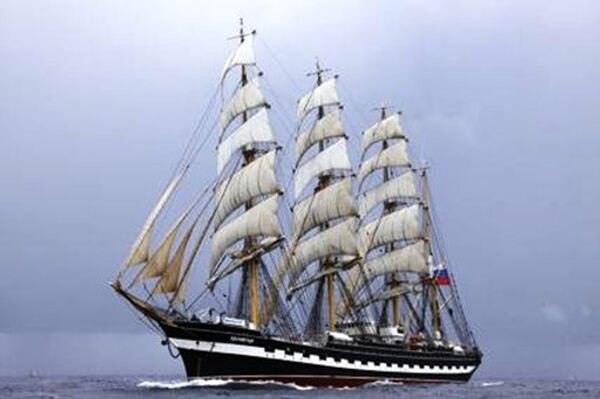The famous Russian four-mast sailing ship Kruzenshtern will be back to its registration port, Kaliningrad, in early May after a six-month voyage as part of the Transatlantic Expedition. Vladimir Volkogon, the rector of the Baltic State Fishing Fleet Academy, which operates the barque, expounds on the expedition results and shares experience of maintaining a unique ship in good shape and teaching hundreds of cadets sailing skills in an interview with RIA Novosti below.
What were the landmarks of the second stage of the Transatlantic Expedition?
The Kruzenshtern covered over 20,000 nautical miles, crossed the equator twice, visited 13 ports and was moored in Vancouver for 18 days during the Winter Olympics. The cadets and crew had a chance to support Russian athletes. The barque had to negotiate the Panama Canal twice to reach Canada’s Pacific coast and back into the Atlantic, for the first time over its 83-year life.
Navigating a real-life sailing ship must certainly feel like an adventure for 16-18 year old boys and girls. What does the Kruzenshtern give them in terms of professional and personal growth?
For naval cadets, serving a practicum at the Kruzenshtern is more than learning sailing skills. It is a chance to explore the operation of the ship’s navigation equipment, try working in the engine room, as the barque was recently equipped with engines. They also continue having regular classes during the voyage, such as English, which they will need in their careers for communicating during moorage in foreign ports. They also do sports and give concerts in ports. But the most important thing is that they learn to shoulder responsibility, mutual support and other vital qualities.
The Kruzenshtern is over 80 years old. The famous barque, named after a legendary Russian navigator, was built in Germany to ship cargos from Latin America to Europe. After WWII, it was transferred to the Soviet Union, and was moored for a long time. How much does it cost to maintain the ship and train future merchant fleet officers?
It’s true, this barque was built in Germany in 1926 as a windjammer class ship and was named The Padova. It was transferred to the Soviet Union in 1946 as a reparation payment. But it was also used for training cadets even before the war. The Kruzenshtern is now operated by the Academy. Its financing is 40-70 million rubles a year, but in 2009-2010 the government allocated additional funds for the International Transatlantic Expedition dedicated to the 65th anniversary of the defeat of Nazi Germany in WWII and the 90th anniversary of the Russian fishing industry.
How are the funds spent?
The money is being used for repairs and for buying newer equipment. We had to replace the Kruzenshtern’s deck three years ago. The new one is made from African oak and will last for many decades. The ship has been equipped with cutting edge navigation devices worth over $200,000. It also has a light-optical compass, one of the most advanced devices of its kind. In Vancouver, cadets of a local naval school visited our ship and said they were a little jealous of what we have.
The opinions expressed in this article are the author's and do not necessarily represent those of RIA Novosti.



